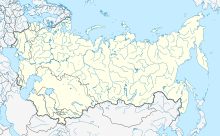
Back Baikonoer AF ميناء بايكونور الفضائي Arabic Cosmódromu de Baikonur AST Baykonur kosmodromu AZ بایکونور اوزای سایتی AZB Байконур BA Байканур BE Байканур (касмадром) BE-X-OLD Байконур Bulgarian বাইকনুর কসমাদ্রোম Bengali/Bangla
Baikonur Cosmodrome | |
|---|---|
 The Cosmodrome's "Gagarin's Start" launchpad on 10 October 2008, prior to the rollout of Soyuz TMA-13. | |
| Summary | |
| Airport type | Spaceport |
| Owner/Operator | |
| Location | |
| Built | 1955 |
| Time zone | AQTT (UTC+05:00) |
| Elevation AMSL | 90 m / 295 ft |
| Coordinates | 45°57′54″N 63°18′18″E / 45.965°N 63.305°E |
| Website | baikonurtour |
| Map | |
Location in the former Soviet Union | |
The Baikonur Cosmodrome[a] is a spaceport operated by Russia within Kazakhstan. Located in the Kazakh city of Baikonur, it is the largest operational space launch facility in terms of area.[1] All Russian crewed spaceflights are launched from Baikonur.[2]
Situated in the Kazakh Steppe, some 90 metres (300 ft) above sea level, it is 200 kilometres (120 mi) to the east of the Aral Sea and north of the Syr Darya. It is close to Töretam, a station on the Trans-Aral Railway. Russia, as the official successor state to the Soviet Union, has retained control over the facility since 1991; it originally assumed this role through the post-Soviet Commonwealth of Independent States (CIS), but ratified an agreement with Kazakhstan in 2005 that allowed it to lease the spaceport until 2050. It is jointly managed by Roscosmos and the Russian Aerospace Forces.[citation needed]
In 1955, the Soviet Ministry of Defence issued a decree and founded the Baikonur Cosmodrome.[3] It was originally built as the chief base of operations for the Soviet space program. The Cosmodrome served as the launching point for Sputnik 1 and Vostok 1. The launchpad used for both missions was renamed "Gagarin's Start" in honour of Soviet cosmonaut Yuri Gagarin, who piloted Vostok 1 and became the first human in outer space.[4] Under the current Russian management, Baikonur remains a busy spaceport, with numerous commercial, military, and scientific missions being launched annually.[5][6][7]
Cite error: There are <ref group=lower-alpha> tags or {{efn}} templates on this page, but the references will not show without a {{reflist|group=lower-alpha}} template or {{notelist}} template (see the help page).
- ^ "Baikonur Cosmodrome 45.9 N 63.3 E". FAS.org. Federation of American Scientists (FAS). Archived from the original on 14 August 2016. Retrieved 19 July 2014.
- ^ Cite error: The named reference
NASAwas invoked but never defined (see the help page). - ^ "Baikonur cosmodrome celebrated 63rd anniversary". Dispatch News Desk. 3 June 2018. Archived from the original on 20 October 2018. Retrieved 19 October 2018.
- ^ "Yuri Gagarin: First Man in Space". Space.com. 13 October 2018. Archived from the original on 20 December 2021. Retrieved 21 December 2021.
- ^ Putz, Catherine (2 June 2015). "World's Most Important Spaceport Turns 60". The Diplomat. Retrieved 14 April 2023.
- ^ "Baikonur Cosmodrome". International Launch Services. Archived from the original on 31 January 2011. Retrieved 6 April 2011.
- ^ Wilson, Jim (5 August 2000). "Safe Launch For Critical Space Station Module". Popular Mechanics.


